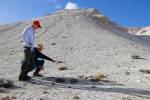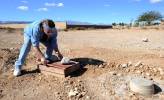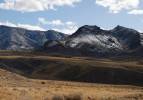Mine lures tribal, habitat group’s opposition
RENO -- Access to a mountain some tribal members consider hallowed ground and the impact on water resources was the focus of testimony Thursday as a hearing continued to determine whether a massive gold mine project in northeast Nevada should be allowed to proceed.
Some Western Shoshone and the environmental group Great Basin Resource Watch are seeking a preliminary injunction in U.S. District Court to halt at least part of Barrick Gold Corp.'s 6,700-acre Cortez Hills Project on Mount Tenabo 250 miles east of Reno.
They argue the mountain holds cultural and religious significance to the Western Shoshone people -- a claim disputed by other Western Shoshone and some experts. They also say environmental studies used by the U.S. Bureau of Land Management in approving the project were flawed.
Barrick has said it expects the operation to produce about 1 million ounces of gold a year in its first full five years of production.
George Fenemore, project manager for the Toronto-based mining company, said in court on Thursday that access to areas around the mine site would be open, though routes in the mountainous region would be realigned.
Much of his testimony concerned a spring or seepage called Shoshone Wells, which would be located close to an area targeted to contain more than 1 billion tons of waste rock dug from an 835-acre, 2,000-foot deep open pit mine.
Western Shoshone involved in the lawsuit say the spring is sacred, and that pumping groundwater to keep the open pit mine from flooding would cause it to dry up.
Fenemore said the spring, which Barrick has monitored since 2001, has a flow of 1 gallon to 2 gallons per minute, and at times has been as low as a half-gallon.
He said water that will need to be pumped to keep the mine pit dry -- a process known as dewatering -- is deep below the spring.
"The water we're intent on moving is the deeper water, several hundred feet below the ground surface," he said during questioning by Barrick lawyer Francis Wikstrom.
He said it's unknown what effect ground water pumping will have on the spring, and that Barrick is required under its permit to monitor the spring "for evidence of drawdown" that could require mitigation.
Under cross examination by the plaintiffs' attorney Roger Flynn, Fenemore said there was no specific plan on how the spring, should it go dry, would be replenished, only that the company has submitted a "menu" of possible options to the BLM.
According to the environmental impact study, the mine would require pumping 50,200 acre-feet of groundwater, or more than 16 billion gallons, over eight-year period.
The study, Flynn said, also noted that groundwater at Shoshone Wells would fall more than 200 feet.
Barrick officials said the pumped water would be piped to nearby Crescent Valley to recharge the aquifer.
U.S. District Judge Larry Hicks scheduled closing arguments for Friday morning. He did indicate when he would rule on the request for the injuction.























